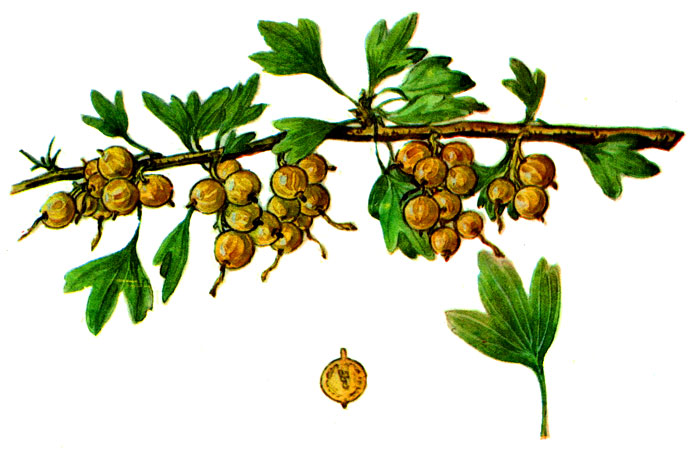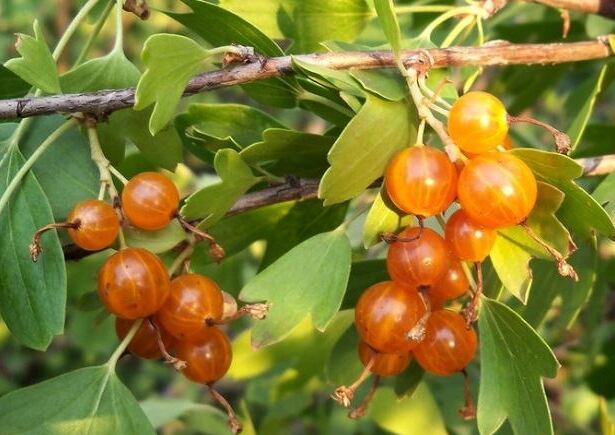Growing and caring for golden currants
Description
North America is rightfully considered the homeland of this variety. On the territory of our country, currants appeared at the beginning of the 19th century. At that time, I.V. Michurin. In one of the issues of the magazine popular in those years called "Garden and Vegetable Garden of the Central Black Earth Region" he writes that he managed to breed excellent new large-fruited hybrid varieties of golden currant.
If we talk about the description of such a currant, which can easily grow on almost any kind of soils - both on light sandy, loamy, and heavy loamy - then it is an outwardly tall shrub that can grow up to 2 - 2, 5 meters.
Golden currant got its name due to the presence of characteristic golden-yellow flowers, which have a pleasant and quite pronounced aroma, which are in brushes of 5 - 7 pieces. The flowering period of this shrub, in contrast to the black currant, falls at a later date, namely the end of May - the beginning of June, and is also longer - up to 15 - 20 days. Thanks to this, the flowers get an excellent opportunity not only to pollinate normally with bumblebees, but also to avoid frost damage, and in the end you get a guaranteed rich harvest.
Experts advise to have at least 3-4 bushes in your garden for good fruiting. An interesting fact is that even berries that grow on one bush of a certain variety of this currant, during ripening, can acquire a different color, which varies from golden yellow to dark cherry. They have a sweet and sour refined taste, and the sizes of berries can be from 4 to 15 mm in diameter. Their ripening time is quite extended, therefore, fully ripe berries are capable of bursting when overripe.
After pollination of the flowers, as the ovary goes into growth, the corolla disappears, and the berries eventually grow with an interesting tail. Since they are not sour, they are even recommended for use by ulcer patients. These berries contain a lot of vitamin A, that is, carotene, even more than sweet peppers or apricots. And they contain more vitamin C than in red currants or gooseberries, but three times less than in black currants.
If we talk about the yield of different varieties of golden currants, including the famous and excellent variety Venus, then it is very high and stable. From a bush that has reached the age of 5 - 7 years, you can collect from 8 to 10 kg of delicious beautiful berries in a season. In Russia, all varieties of this currant, including Venus, are considered rather exotic, compared to black currant. But they are a real discovery and are perfect for planting on a personal plot even for novice gardeners, since they have many advantages.
Such shrubs have a good degree of frost resistance, are able to grow normally and fully develop even in severe winters, they also easily tolerate the presence of shade, do not impose special requirements on any of the soil types, are attractive to hornets and bees, due to which they are well pollinated, have very extended ripening period, which makes it possible to collect a high yield of berries, unpretentious to care, which makes it easier for beginners and experienced gardeners to care for this crop.
Growing
Reproduction of golden currants is possible in several ways - by sowing seeds, dividing a bush, planting cuttings of green and lignified branches, layering or annual shoots (akin to raspberries). The most laborious is considered to be the reproduction of this type of currant by growing seedlings. When choosing this method, varietal characteristics are practically not preserved. And the resulting fruit crops are good rootstocks for varietal forms of gold, black, white, red currants, yoshta and gooseberries. If we talk about sowing seeds of various varieties, then it is advised to carry it out before winter or with the arrival of spring.
Before planting in the spring season, the seeds will need to be pre-stratified for about three months, using a freezer for this purpose. When the time comes to plant the seeds in the ground, they will be placed in a container where the nutrient soil disinfected with the help of special preparations will already be located, after which they will be kept in a warm room where there is normal lighting. After a couple of weeks, you can see the first shoots, which will require minimal maintenance. When the seedlings have about 4 full leaves, they are dived and placed in a shaded place. You should know that one-year-old seedlings planted on your garden plot are capable of bearing fruit the next year, but varietal ones - only after three or four.
It is recommended to plant seedlings in the spring or autumn period, the main thing is to do this long before the onset of the first frost is expected. The growing season for this plant usually lasts from mid-April to mid-September. The optimal time for planting seedlings is considered to be the time before or after the end of sap flow. But those seedlings that you purchase in special fruit nurseries in pots with closed roots can be planted in the ground in almost any period that fits into the framework of the spring-autumn period. It is customary to plant seedlings according to the proven scheme 120 by 250 cm.
Since this culture has a tendency to cross-pollination, then, as mentioned above, it is advised to plant several varieties together in the garden. Immediately before planting in the soil, the seedlings should be inspected for mechanical damage, after which they need to shorten the shoots, while leaving about three buds. Then the roots are soaked in clay solution and planted in a prepared pit, the volume of which for a one-year-old seedling should be 60 by 60 by 60 cm.A bucket of rotted compost, 5 glasses of wood ash and potassium-phosphorus fertilizers are also introduced into the pit.
Since currants of this type tend to branch well, many gardeners use this to grow it in a standard form. If you regularly remove the shoots, leaving only one branch, then you can form an unusual tree from it, the length of which can be about three meters. And in the event that a red, white or black currant is grafted onto such a branch, then these shrubs can also be grown in a standard form. The resulting plant will differ not only in durability and good health, but will also delight its owner with larger berries.
The golden subspecies of currant loves the presence of light, and its fruits will be larger and more juicy if such a shrub is grown in open, sunny places.
Given the deep penetration of roots into the ground, a site with a low groundwater table is preferable. Currants are resistant to pests and diseases, as well as pathogens and gas contamination, which allows it to fully grow and develop even when your personal plot is located in close proximity to any highway or enterprise.In the regions of our country, it is customary to grow golden currants not only as a fruit shrub, but also as an ornamental plant. Because her bushes remain very beautiful from spring to autumn. Their arched branches are decorated with golden flowers for three weeks, exuding a wonderful aroma in spring, in summer they can be seen shiny berries, and with the arrival of autumn, you can enjoy the view of the crimson foliage.
Video "Care and Growing"
Care
Even a gardener who does not have deep knowledge and sufficient practical experience in this area can safely take care of the golden currant growing on the site. Proper care of golden currants includes not only sufficient regular watering, but also shrub pruning and fertilization.
The methods of pruning and shaping bushes here are somewhat different from those that are used when caring for black and red currants. Since the main crop traditionally appears on 3 - 4-year-old wood, pruning should be carried out taking into account this feature. If you carry out careful pruning in the very first year after planting the shrub in the soil, as well as plant it with a strong slope of the plant, then you can get a bush with a fairly wide base as a result. Therefore, experts and experienced gardeners advise in the first year to do without pruning. Only in the second year is it recommended to remove weak basal shoots in order to enable viable shoots to fully grow and develop.
To achieve better branching, the shoots must be shortened by about a third of their length. In the third year, it is recommended to leave last year's branches, and also not to remove about 3 - 6 of the most viable annual shoots. A fully formed 4-year-old shrub should ideally have up to 35 branches of varying ages. Later, you need to carry out sanitary pruning in order to provide the bush with good ventilation conditions and normal access to light. To do this, weak drooping branches will need to be made smaller in the place where the bend to the side branch occurs. As a rule, it is located slightly above the trimming point. Golden currant is considered among gardeners to be a very grateful fruit crop, since, in addition to pruning, it requires ordinary moderate watering, as well as double feeding before the onset of the fruiting period.
Video "All about golden currant"
From the video of the decorative and fruit guide, you will learn what are the standards for caring for this variety of currants.







